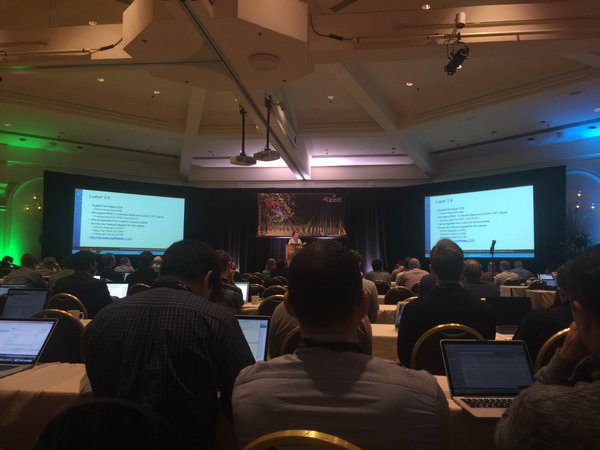
Photo courtesy of Jeff Johnson
In this special guest feature, Ken Strandberg offers this live report from Day 1 of the Lustre User Group meeting in Portland.
The Lustre User Group (LUG) 2016 conference is well under way. The morning of the first day was spent on looking at Lustre today and tomorrow and security developments in the code. Peter Jones and Andreas Dilger described what is in the newest release of Lustre 2.8 and will be in Lustre 2.9, targeted for release this fall, and beyond. These features include growing support for ZFS, security, multi-rail LNET, progressive file layouts, project quotas, and more.
Lawrence Morrone and Giuseppe Di Natale from LLNL have created a community build site (http://build.lustre.org) for Lustre where Lustre code can be built for various Linux distributions. The system is based on buildbot* and currently hosts several different builds. Morrone and Di Natale plan on the site offering a complete process of code building and testing for the open source software. The site and the system is in its early stages.
Security in storage has been a topic of considerable interest. Several developments were presented that will help protect Lustre data more strongly. Intel has been working on incorporating Kerberos encryption and SELinux authentication for the client, while DDN is incorporating Linux containers into a security strategy that uses Kerberos authentication for access to data. Warp Mechanics has deposited into the open source repository a complementary mechanism that enables users to create black and white lists of Lustre clients—a sort of IP tables for Lustre.
The afternoon began with the announcement from Peter Bojanic from Seagate that the huge storage company, once a competitor with Intel, will be offering the Intel® Enterprise Edition for Lustre* software as part of their solutions. Seagate and Intel have been working on their own developments for, contributions to, and distributions of Lustre for several years. Yesterday’s announcement forms a collaboration of the two giant companies and their resources. This is good news for the Lustre community, bringing together two power houses with their considerable commitments to and investments in the software for the benefit of creating a more capable open source Lustre code base for both HPC and enterprise workloads. The full announcement from Seagate, with responses from Intel and the wider community, can be read here.
Jinshan Xiong and Fan Yong both presented Intel’s continuing investments in the ZFS file system in Lustre to optimize performance and provide snapshots. Gvozden Neskovic from the Frankfurt Institute for Advanced Studies presented his work on RAIDZ in ZFS.
Charlie Carroll from Cray, an OpenSFS* board member, revealed things will be changing in OpenSFS. OpenSFS has been a driver of Lustre development, management, and releases. OpenSFS’ new role will focus on the community. Exactly how the organization will change is part of an open discussion to be held today in an OpenSFS board panel Q & A that will bring the attendees of the conference together to discuss the way forward.
Several more topics were covered in Tuesday’s presentations, which will eventually all be available at www.opensfs.org.
Read the full report from LUG Day 2 and LUG Day 3.




Slide presentations from LUG 2016 are now available at
http://opensfs.org/lug-2016-agenda/